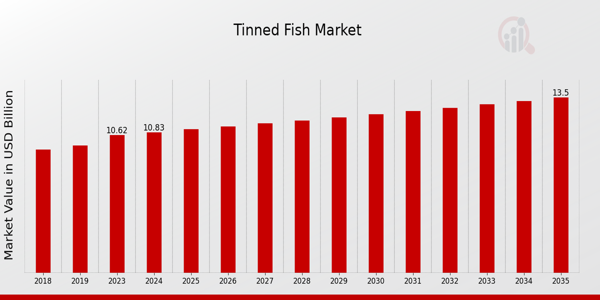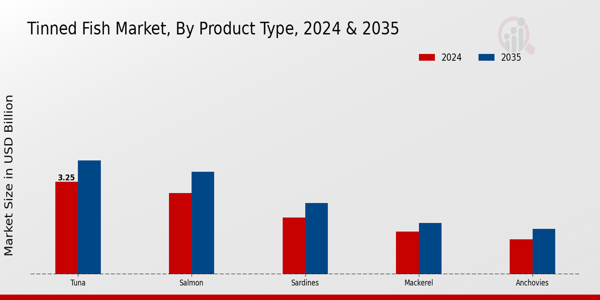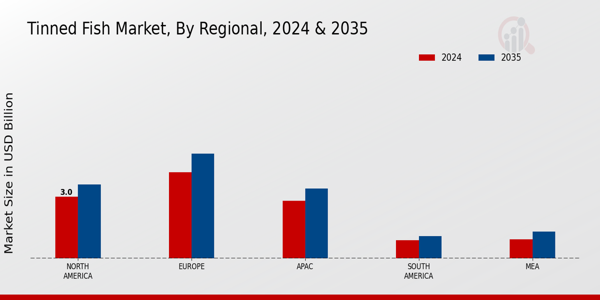Tinned Fish Market Overview:
As per MRFR analysis, the Tinned Fish Market Size was estimated at 10.62 (USD Billion) in 2023. The Tinned Fish Market Industry is expected to grow from 10.83 (USD Billion) in 2024 to 13.5 (USD Billion) by 2035. The Tinned Fish Market CAGR (growth rate) is expected to be around 2.02% during the forecast period (2025 - 2035).
Key Tinned Fish Market Trends Highlighted
The Global Tinned Fish Market is seeing remarkable expansion due to the growing consumer trend towards non-perishable, ready-to-eat meals. These foods are becoming commonplace as people are regularly unable to find time to eat, and there is a concerning shift on the focus for protein based products that can be stored over long periods. Moreover, the benefits that fish have on health are driving the tinned fish products demand considerably. There is increasing concern with regard to the types of brands consumers buy as there is now a heavier emphasis on sustainable environmental practices, although eco-friendly operations are becoming softer on brand image. The possibility of augmenting flavor and modifying product formats provides an endless array of opportunities for companies striving to be innovative.
The trend towards health-conscious eating invites brands to explore ways to enhance nutritional content, such as incorporating superfoods or reducing sodium levels. There is also room for expansion in emerging markets where consumers are becoming increasingly health-aware and open to trying new products. Leveraging online retail platforms can further increase accessibility and convenience for consumers seeking tinned fish options. In recent times, the market has seen an uptick in gourmet and specialty products, appealing to more diverse palates. Consumers are not only looking for convenience but also unique flavor experiences, driving brands to develop premium offerings.Additionally, the growth of e-commerce has paved the way for a broader reach, enabling consumers to discover a variety of tinned fish products from around the globe. Overall, the demand for tinned fish products continues to evolve, influenced by lifestyle changes, health trends, and a growing focus on sustainability.

Source: Primary Research, Secondary Research, MRFR Database and Analyst Review
Tinned Fish Market Drivers
Rising Demand for Convenient and Long-Lasting Food Products
The Global Tinned Fish Market Industry is experiencing significant growth driven by the increasing consumer preference for convenience and longevity in food products. With the fast-paced lifestyle of modern consumers, there is a rising need for ready-to-eat meals that require minimal preparation time. Tinned fish serves as an ideal solution, offering not just convenience but also a long shelf life. Moreover, the enhanced nutritional profile of many tinned fish products appeals to health-conscious consumers.This trend is further bolstered by the growing awareness of nutritionally rich foods, and tinned fish is often highlighted for its high protein and omega-3 fatty acid content. The market is witnessing innovation in flavors and varieties, making tinned fish products more appealing to consumers of all demographics. Additionally, as global awareness about food waste intensifies, the ability to store tinned fish for extended periods is seen as a sustainable practice.This aspect resonates particularly well with eco-conscious consumers. The trend towards packaged and processed foods is expected to continue, further propelling the growth of the Global Tinned Fish Market. The ongoing shift in dietary habits, leaning towards more protein-rich and low-carb diets, aligns well with the nature of tinned fish offerings, thus fostering an environment conducive to sales growth and market expansion.
Growing Popularity of Seafood-based Diets
The Global Tinned Fish Market Industry is witnessing a notable increase in the popularity of seafood-based diets. As health trends shift towards low-fat, high-protein diets, consumers are increasingly incorporating fish into their meals due to its numerous health benefits. Tinned fish provides a quick and convenient way to access these benefits, thus enhancing its appeal. The variety of options, which include tuna, sardines, and mackerel, caters to diverse consumer preferences and dietary restrictions.
Innovations in Packaging and Sustainability Initiatives
In recent years, there has been a significant push towards sustainability in the Global Tinned Fish Market Industry. Innovations in packaging, such as the use of recyclable materials, have been well received by environmentally conscious consumers. Brands focusing on sustainable sourcing of fish also gain competitive advantages as they meet the growing demand for ethically produced food products.
Tinned Fish Market Segment Insights:
Tinned Fish Market Product Type Insights
The Global Tinned Fish Market is multifaceted, with a notable segmentation based on product types, primarily including Tuna, Salmon, Sardines, Mackerel, and Anchovies. In 2024, the overall market was positioned to reach a valuation of 10.83 USD Billion, showcasing the robust demand for tinned fish products. Focusing on Tuna, this product type commands a significant share with a valuation of 3.25 USD Billion in 2024, reflecting its popularity and prominent role among consumers who prefer its flavor and versatility in various cuisines.
Following closely, Salmon is anticipated to reach a value of 2.85 USD Billion in the same year, highlighting its significance due to health trends that favor omega-3 fatty acids associated with its consumption. Sardines also hold a substantial place in the market, estimated to provide a revenue of 2.0 USD Billion in 2024, benefiting from their reputation for affordability and nutritional value, making them a popular choice among budget-conscious consumers.
When delving into Mackerel, this product type exhibits a valuation of 1.5 USD Billion, which is modest yet important, as it appeals notably to specific demographics that appreciate its strong flavor and nutritional benefits. Anchovies, while valued at 1.23 USD Billion in 2024, enjoy a significant niche in gourmet culinary applications, often utilized for their distinctive taste in various dishes. The Global Tinned Fish Market segmentation indicates that Tuna and Salmon together dominate a notable majority of the revenue, reflecting consumer preferences and market trends that lean towards healthier protein sources. The anticipated growth in this industry can be attributed to increasing consumer awareness regarding nutrition and convenience, as well as the ongoing trend among consumers to seek diverse protein sources.
As we progress towards 2035, it's essential to recognize that Tuna is projected to surge to a value of 4.0 USD Billion, maintaining its leading position, while Salmon is expected to rise to 3.6 USD Billion. Sardines are also poised for growth, expected to reach 2.5 USD Billion, driven by ongoing trends focused on sustainable seafood options. Mackerel will likely see a slight increase to 1.8 USD Billion, highlighting its niche appeal, while Anchovies are expected to grow to 1.6 USD Billion, further signifying their culinary relevance.
Overall, this progression reflects broader market trends within the Global Tinned Fish Market that favor health-conscious choices, convenience, and the increasing popularity of ready-to-eat seafood. The insights derived from this product type segmentation are crucial for stakeholders aiming to grasp market demands and align their strategies accordingly amid the evolving landscape of consumer preferences and nutritional awareness.

Source: Primary Research, Secondary Research, MRFR Database and Analyst Review
Tinned Fish Market Packaging Type Insights
The Global Tinned Fish Market is projected to reach a valuation of 10.83 billion USD in 2024, reflecting a growing demand for various packaging types that cater to consumer preferences. The market is segmented into diverse packaging options, including canned, pouch, glass jar, and tin can. Among these, canned packaging continues to dominate the market due to its convenience and long shelf life, making it a favorite for both retailers and consumers. Pouch packaging has gained prominence in recent years, appealing particularly to consumers seeking easy-to-carry and lightweight options.Glass jars, while a smaller segment, offer a premium appeal with a focus on sustainability and food safety, attracting environmentally conscious consumers. Tin cans also hold a significant share, known for their recyclability and durability. The overall growth of the Global Tinned Fish Market revenue is driven by changing dietary preferences, increased demand for convenient food options, and the rising popularity of seafood in various culinary applications. There are also emerging opportunities for innovative packaging solutions to enhance product shelf life and reduce food waste.
Tinned Fish Market End User Insights
The Global Tinned Fish Market, valued at 10.83 USD billion in 2024, shows a clear trend toward segmentation based on end-user applications, which include Household, Food Service, and Industrial categories. The Household sector plays a significant role, catering to the basic necessity of nutritious and convenient meal options, thus driving substantial demand in the market. The Food Service segment also holds a major share as restaurants and cafes adopt tinned fish as versatile ingredients in their menu offerings, responding to the growing consumer preference for ready-to-eat meals.Meanwhile, the Industrial category contributes to the market by utilizing tinned fish products in large-scale operations, fueling production for various food items. This segmentation highlights how different user applications impact the overall dynamics of the Global Tinned Fish Market. The increasing awareness about health benefits associated with fish consumption, alongside a rising trend toward convenience, is pushing further growth across these segments, providing significant opportunities for stakeholders in the market.
Tinned Fish Market Flavor Insights
The Flavor segment of the Global Tinned Fish Market significantly contributes to the overall market dynamics, with trends indicating a shift toward diverse flavor profiles among consumers. By 2024, the Global Tinned Fish Market was valued at approximately 10.83 billion USD, showcasing robust growth driven by increasing consumer preference for convenience and ready-to-eat options. Among the flavor offerings, Plain options maintain a steady demand, appealing to traditional palates, while Spicy variants are gaining traction as more consumers seek bold, adventurous tastes.The Smoked category is also notable, as its unique flavor enhances the culinary experience, making it a popular choice for gourmet applications. Marinated flavors are embraced for their rich, layered profiles, often paired with various cuisines, while Sour flavors cater to niche markets with specific culinary traditions. Overall, the diverse palate preferences reflect evolving consumer tastes and lifestyles, presenting opportunities for innovation within each flavor category in the Global Tinned Fish Market. With so many choices available, understanding these preferences helps manufacturers target their products effectively, aligning with market growth and consumer demand.
Tinned Fish Market Regional Insights
The Global Tinned Fish Market demonstrates notable regional variations, with distinct valuations across different areas. In 2024, the market for North America was valued at 3.0 USD Billion, indicating a significant presence in the industry, which can be attributed to strong consumer demand and robust distribution channels. Europe leads with a valuation of 4.2 USD Billion, dominating the market largely due to a high consumption rate and preference for dietary convenience. The APAC region follows closely, with a market size of 2.8 USD Billion, reflecting a growing trend towards ready-to-eat meals and a rising middle class.South America and MEA exhibit smaller market sizes, valued at 0.9 USD Billion and 0.93 USD Billion in 2024, respectively, showcasing emerging interests in tinned fish products but facing challenges in market penetration and brand recognition. Overall, the Global Tinned Fish Market segmentation highlights Europe's significant share, while North America represents a vital part of consumption patterns, influencing market growth trends and providing substantial opportunities for key players in the industry.

Source: Primary Research, Secondary Research, MRFR Database and Analyst Review
Tinned Fish Market Key Players and Competitive Insights:
The Global Tinned Fish Market has seen significant growth and transformation as consumer preferences have shifted towards convenient and nutritious food options. Competitive dynamics in this sector involve a myriad of players, each vying to capture market share through innovative product offerings, strategic marketing approaches, and sustainable practices. As consumer demand rises, companies are adapting to changing trends, such as an increased focus on health and sustainability, which has further fueled competition. Factors such as taste, quality, packaging, and sourcing practices are pivotal in determining the competitive stance of firms within this space. Furthermore, regulatory standards and environmental considerations are increasingly shaping the strategies of companies aiming to maintain a robust presence in the global market.Wild Planet Foods has established itself as a leading player in the Global Tinned Fish Market, leveraging its commitment to sustainability and high-quality ingredients. The company emphasizes eco-friendly sourcing practices, primarily focusing on wild-caught fish and using methods that prevent overfishing. This environmentally responsible approach has resonated with modern consumers who prioritize health and sustainability. In addition to its sustainable practices, Wild Planet Foods offers a diverse range of products, catering to different tastes and dietary preferences, which strengthens its position in the market. Their innovative packaging, which focuses on retaining product freshness and quality, further enhances consumer appeal, making Wild Planet Foods a strong contender in a competitive landscape where consumers are increasingly seeking transparency in food sourcing and the health benefits of their meals.Starkist is another key player in the Global Tinned Fish Market, known for its extensive product range and strong brand recognition. The company's commitment to quality has established it as a trusted name among consumers seeking convenient meal solutions. Starkist's innovative marketing strategies have effectively captured a wide audience, tying in the product's usage versatility with lifestyle trends. The brand often highlights convenience, nutrition, and taste, appealing to busy consumers looking for quick and healthy meal options. Starkist has successfully created a strong distribution network that ensures its products are widely available, thereby reinforcing its market presence. The company continues to innovate with new flavors and product lines, maintaining its competitive edge in a market that increasingly leans towards convenience and health-centric offerings.
Key Companies in the Tinned Fish Market Include:
- Wild Planet Foods
- Starkist
- Genova Seafood
- Chicken of the Sea
- Häagen Dazs
- Crown Prince
- Del Monte Foods
- Northwest Fish
- Mackerel Fish Company
- Anglo Atlantic
- Thai Union Group
- Bumble Bee Foods
- Ocean Save
- Sierra Fish Company
- Eden Foods
Tinned Fish Market Industry Developments
In recent developments, the Global Tinned Fish Market has observed increasing demand driven by consumer preferences for sustainable and convenient food sources. Companies like Wild Planet Foods and Bumble Bee Foods are emphasizing their sustainability initiatives to attract environmentally conscious consumers. Additionally, Starkist has been expanding its product range to include more gourmet options, further diversifying its offerings in response to evolving market demands. Mergers and acquisitions in the market have also been notable, with Thai Union Group completing strategic acquisitions to enhance its presence, thus shaping competitive dynamics. Ocean Save and Chicken of the Sea are exploring partnerships aimed at improving supply chain efficiency and sustainability practices. The growth in market valuation, particularly for companies like Del Monte Foods and Genova Seafood, indicates a robust increase in profitability, further fueling investment in innovative production techniques and sustainable practices. This focus on sustainability and diversification is set to redefine the market landscape, with Northwest Fish and Crown Prince also benefiting from these trends. Overall, the alignment of consumer values with corporate strategies is helping to propel the tinned fish market toward considerable growth opportunities.
Tinned Fish Market Segmentation Insights
Tinned Fish Market Product Type Outlook
- Tuna
- Salmon
- Sardines
- Mackerel
- Anchovies
Tinned Fish Market Packaging Type Outlook
- Canned
- Pouch
- Glass Jar
- Tin Can
Tinned Fish Market End User Outlook
- Household
- Food Service
- Industrial
Tinned Fish Market Flavor Outlook
- Plain
- Spicy
- Smoked
- Marinated
- Sour
Tinned Fish Market Regional Outlook
- North America
- Europe
- South America
- Asia-Pacific
- Middle East and Africa
| Attribute/Metric Source: |
Details |
| MARKET SIZE 2023 |
10.62(USD Billion) |
| MARKET SIZE 2024 |
10.83(USD Billion) |
| MARKET SIZE 2035 |
13.5(USD Billion) |
| COMPOUND ANNUAL GROWTH RATE (CAGR) |
2.02% (2025 - 2035) |
| REPORT COVERAGE |
Revenue Forecast, Competitive Landscape, Growth Factors, and Trends |
| BASE YEAR |
2024 |
| MARKET FORECAST PERIOD |
2025 - 2035 |
| HISTORICAL DATA |
2019 - 2024 |
| MARKET FORECAST UNITS |
USD Billion |
| KEY COMPANIES PROFILED |
Wild Planet Foods, Starkist, Genova Seafood, Chicken of the Sea, Häagen Dazs, Crown Prince, Del Monte Foods, Northwest Fish, Mackerel Fish Company, Anglo Atlantic, Thai Union Group, Bumble Bee Foods, Ocean Save, Sierra Fish Company, Eden Foods |
| SEGMENTS COVERED |
Product Type, Packaging Type, End User, Flavor, Regional |
| KEY MARKET OPPORTUNITIES |
Sustainable sourcing practices, Innovative flavor profiles, E-commerce expansion, Health-conscious product lines, Premium and gourmet offerings |
| KEY MARKET DYNAMICS |
Rising consumer health awareness, Increasing demand for convenience foods, Sustainable sourcing trends, Growth in e-commerce sales, Expanding flavor variety offerings |
| COUNTRIES COVERED |
North America, Europe, APAC, South America, MEA |
Frequently Asked Questions (FAQ) :
The expected market size of the Global Tinned Fish Market in 2024 is projected to be 10.83 USD Billion.
By 2035, the Global Tinned Fish Market is forecasted to reach a value of 13.5 USD Billion.
The expected compound annual growth rate (CAGR) for the Global Tinned Fish Market from 2025 to 2035 is 2.02%.
In 2024, Europe is projected to hold the largest share of the Global Tinned Fish Market, valued at 4.2 USD Billion.
The market size of North America for tinned fish is expected to reach 3.6 USD Billion by 2035.
The expected market size for Tuna in the Global Tinned Fish Market in 2024 is valued at 3.25 USD Billion.
Key players in the Global Tinned Fish Market include companies like Wild Planet Foods, Starkist, and Thai Union Group.
The Sardine segment of the Global Tinned Fish Market is projected to be valued at 2.5 USD Billion in 2035.
The Asia-Pacific region is expected to see growth opportunities with a market size of 3.4 USD Billion by 2035.
Tuna is expected to grow the most, reaching a market value of 4.0 USD Billion by 2035.

















